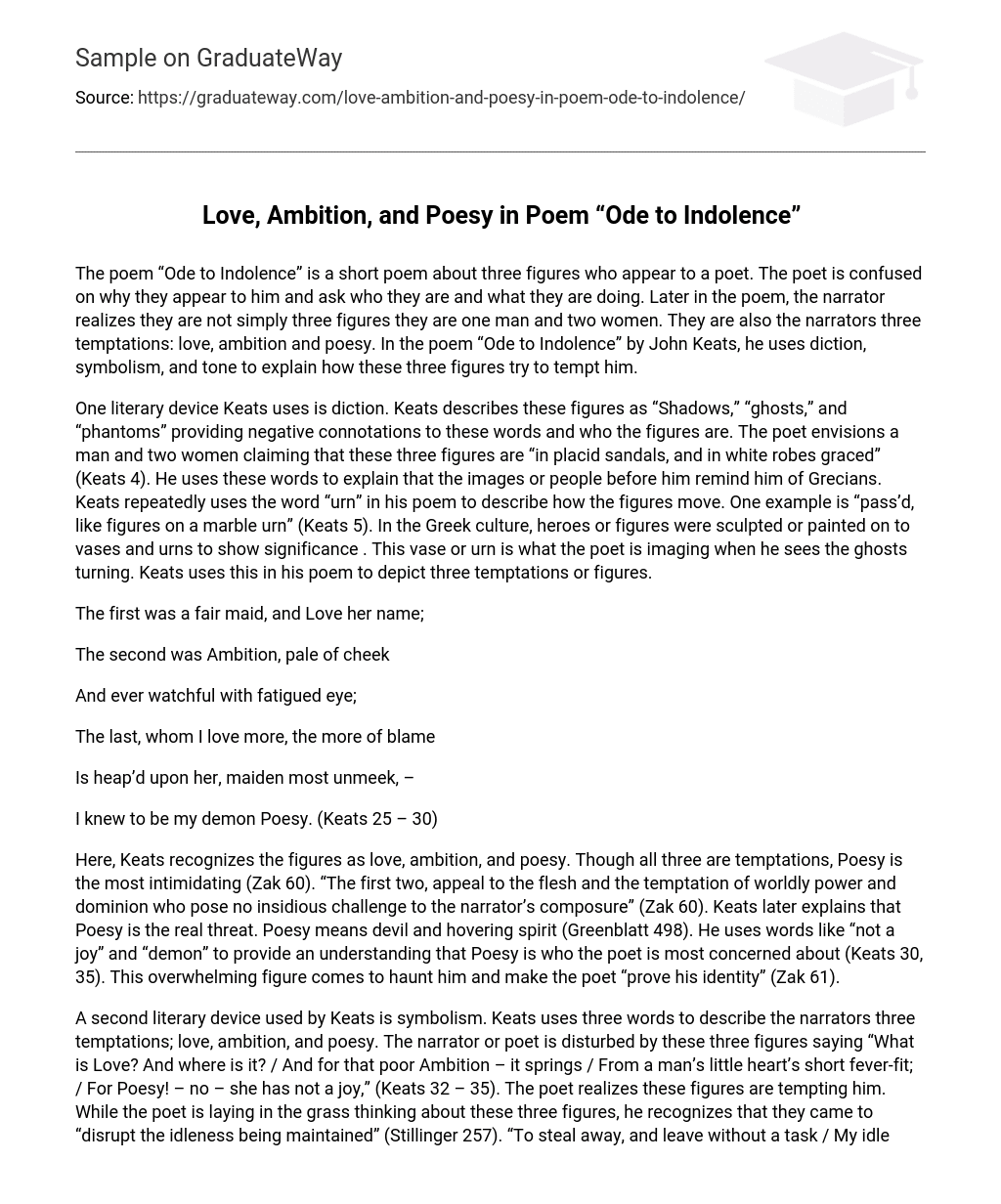The poem “Ode to Indolence” is a short poem about three figures who appear to a poet. The poet is confused on why they appear to him and ask who they are and what they are doing. Later in the poem, the narrator realizes they are not simply three figures they are one man and two women. They are also the narrators three temptations: love, ambition and poesy. In the poem “Ode to Indolence” by John Keats, he uses diction, symbolism, and tone to explain how these three figures try to tempt him.
One literary device Keats uses is diction. Keats describes these figures as “Shadows,” “ghosts,” and “phantoms” providing negative connotations to these words and who the figures are. The poet envisions a man and two women claiming that these three figures are “in placid sandals, and in white robes graced” (Keats 4). He uses these words to explain that the images or people before him remind him of Grecians. Keats repeatedly uses the word “urn” in his poem to describe how the figures move. One example is “pass’d, like figures on a marble urn” (Keats 5). In the Greek culture, heroes or figures were sculpted or painted on to vases and urns to show significance . This vase or urn is what the poet is imaging when he sees the ghosts turning. Keats uses this in his poem to depict three temptations or figures.
The first was a fair maid, and Love her name;
The second was Ambition, pale of cheek
And ever watchful with fatigued eye;
The last, whom I love more, the more of blame
Is heap’d upon her, maiden most unmeek, –
I knew to be my demon Poesy. (Keats 25 – 30)
Here, Keats recognizes the figures as love, ambition, and poesy. Though all three are temptations, Poesy is the most intimidating (Zak 60). “The first two, appeal to the flesh and the temptation of worldly power and dominion who pose no insidious challenge to the narrator’s composure” (Zak 60). Keats later explains that Poesy is the real threat. Poesy means devil and hovering spirit (Greenblatt 498). He uses words like “not a joy” and “demon” to provide an understanding that Poesy is who the poet is most concerned about (Keats 30, 35). This overwhelming figure comes to haunt him and make the poet “prove his identity” (Zak 61).
A second literary device used by Keats is symbolism. Keats uses three words to describe the narrators three temptations; love, ambition, and poesy. The narrator or poet is disturbed by these three figures saying “What is Love? And where is it? / And for that poor Ambition – it springs / From a man’s little heart’s short fever-fit; / For Poesy! – no – she has not a joy,” (Keats 32 – 35). The poet realizes these figures are tempting him. While the poet is laying in the grass thinking about these three figures, he recognizes that they came to “disrupt the idleness being maintained” (Stillinger 257). “To steal away, and leave without a task / My idle days?” (Keats 14,15). Here the poet is questioning why they are present. The three figures symbolize exactly what their names mean. However, if their goal was to ruin his idleness, the ghosts are doing the opposite. Instead of interrupting his peace like they came to do, they are contributing to it (Stillinger 257). They are not tempting him at all. The narrator Knowns these three temptations are faulty and unfulfilling. Love does not last forever, ambition is short lived, and poesy has nothing to offer.
Lastly, the narrator uses tone to enhance the poem. In the beginning of the poem, the tone is that of a disturbed man. All the narrator wants is “evenings steep’d in honied indolence” (Keats 37). These figures came to interrupt him; however, he will not be tempted. Towards the end of the poem we see the man stand up for himself and the tone is almost triumphant. “So, ye three ghosts, adieu!” (Keats 51). The poet denies them the right to distract him any longer and sends them away saying “Vanish, ye phantoms, from my idle spright, / Into the clouds, and never more return!” (Keats 59, 60). The narrator realizes they will never bring him happiness and sends them away to enjoy the rest of his day in indolence.
In conclusion, Keats uses diction, symbolism, and tone to explain temptation the narrator is facing. Love, ambition, and poesy are three things the poet desires. Throughout the poem we see how all three temptations work together to overwhelm the poet. However, the poet realizes all three figures have nothing to offer him and he is better off just staying where he is. The two temptations Love and Ambition were easy for the narrator to discard making Poesy the most difficult to get out of the poets head. In the end it is easy to understand that the poet overpowered his desires creating a tone of success (Zak 64).





